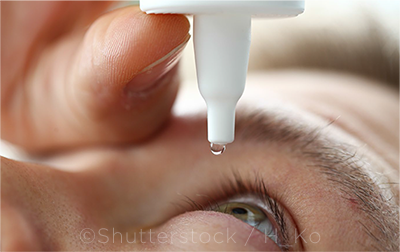Download PDF
A novel antioxidant eyedrop shows promise of being an effective treatment for presbyopia, with a first-in-class pharmaceutical approach to addressing one of the biggest remaining refractive challenges in ophthalmology.
Unlike other potential presbyopia eyedrops on the horizon,1 the drug (UNR844, 1.5% solution, Novartis) does not rely on the pinhole effect. Instead, it aims at directly enhancing the eye’s accommodative apparatus by increasing lens deformability and elasticity.2
 |
RESTORING ACCOMMODATION. The eyedrop appears to increase lens elasticity.
|
Study specifics. In a small phase 1/2 dosing and safety study, the treated patients (n = 50) showed statistically significant improvements in distance-corrected near visual acuity (DCNVA) when compared to those who received placebo drops (n = 25).2 The improvements were detected at day 8 (p = 0.024) and continued to increase at every study visit thereafter, until dosing ended at day 91 (p = 0.001).
Outcomes. At day 91, the mean change (standard deviation [SD]) in VA was –0.159 (+0.120) LogMAR in treated eyes, versus –0.079 (+0.116) in eyes receiving placebo drops (p = 0.007). Improvements in DCNVA were largely sustained over the seven-month period that followed the 91 days of dosing, although there was some attenuation of the effect over time. No significant adverse ocular or systemic effects were observed in either cohort.
Mechanism of action. UNR844’s active ingredient is a prodrug lipoic acid choline ester, which—when inside lens fiber cells—is metabolized into the antioxidant dihydrolipoic acid (DHLA). Inside the lens, DHLA reduces the formation of disulfide bonds between lens proteins in the aqueous humor’s oxidizing environment. (During the natural progression of presbyopia, these disulfide bonds accumulate in the lens with age, stiffening it.3) Fewer disulfide bonds and consequent softening of the lens are thought to restore the lens’ ability to accommodate.
A new era? Even though much research remains to be done—including a larger safety study and a phase 3 efficacy trial—the early results in the preliminary safety study are promising, said principal investigator Michael S. Korenfeld, MD, in private practice in Washington, Missouri. “This medication has potential for the treatment of a condition that affects pretty much everyone who lives past age 40,” Dr. Korenfeld said.
Unanswered questions. Among the questions about UNR844 that remain to be answered are whether daily dosing beyond 91 days would increase the improvements seen in the current study, Dr. Korenfeld said.
Researchers also will need to develop a way to stabilize UNR844 for commercial use. “This is an antioxidant drug that is vulnerable in a way that most drugs are not. If it is exposed to oxygen, it loses its potency,” Dr. Korenfeld said. “So in order to maintain full potency, Novartis will have to maintain the formulation in a reduced state in a world full of oxygen. This indeed will be tricky.”
—Linda Roach
___________________________
1 Grzybowski A et al. Asia Pac J Ophthalmol (Phila). 2020;9(3):226-233.
2 Korenfeld MS et al. Eye (Lond). Published online Jan. 29, 2021.
3 Garner WH, Garner MH. Invest Ophthalmol Vis Sci. 2016;57(6):2851-63.
___________________________
Relevant financial disclosures: Dr. Korenfeld—Encore Vision: S; Novartis: C,S; Orasis: C.
For full disclosures and the disclosure key, see below.
Full Financial Disclosures
Dr. Korenfeld Encore Vision: S; EyeGate: C; EyePoint: C; Novartis: C,S; Orasis: C.
Dr. Shekhawat NEI: S.
Dr. Teo Bayer: L; Novartis: L; Topcon: L.
Dr. Woreta None.
Dr. WuDunn Allergan: S.
Disclosure Category
|
Code
|
Description
|
| Consultant/Advisor |
C |
Consultant fee, paid advisory boards, or fees for attending a meeting. |
| Employee |
E |
Employed by a commercial company. |
| Speakers bureau |
L |
Lecture fees or honoraria, travel fees or reimbursements when speaking at the invitation of a commercial company. |
| Equity owner |
O |
Equity ownership/stock options in publicly or privately traded firms, excluding mutual funds. |
| Patents/Royalty |
P |
Patents and/or royalties for intellectual property. |
| Grant support |
S |
Grant support or other financial support to the investigator from all sources, including research support from government agencies (e.g., NIH), foundations, device manufacturers, and/or pharmaceutical companies. |
|
More from this month’s News in Review